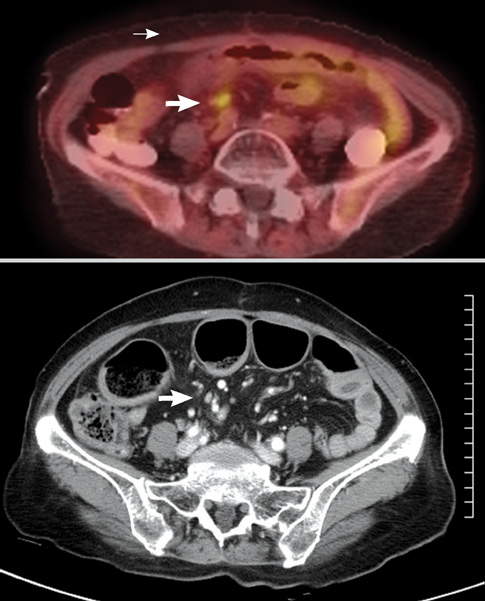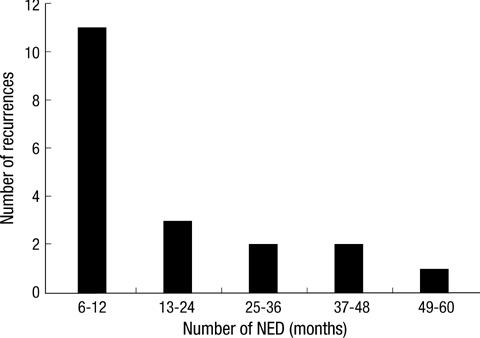J Korean Med Sci.
2010 Jul;25(7):1029-1033. 10.3346/jkms.2010.25.7.1029.
Detection of Recurrence by 18F-FDG PET in Patients with Endometrial Cancer Showing No Evidence of Disease
- Affiliations
-
- 1Department of Obstetrics & Gynecology, Korea Cancer Center Hospital, Korea Institute of Radiological and Medical Sciences (KIRAMS), Seoul, Korea. ryu@kcch.re.kr
- 2Department of Nuclear Medicine, Korea Cancer Center Hospital, Korea Institute of Radiological and Medical Sciences (KIRAMS), Seoul, Korea.
- KMID: 1792952
- DOI: http://doi.org/10.3346/jkms.2010.25.7.1029
Abstract
- This study assessed the feasibility of F-18-fluorodeoxyglucose positron-emission tomography (18F-FDG PET) in the post-therapy surveillance for patients with endometrial cancer showing no evidence of disease (NED). From April 1997 to June 2007, 127 patients with endometrial cancer showing NED were performed 18F-FDG PET scan. The feasibility of 18F-FDG PET for the early detection of recurrence in patients with endometrial cancer was evaluated retrospectively. Of the 127 patients, 32 patients showed positive lesions on 18F-FDG PET scan. Nineteen (19/127 cases, 15%) of them were confirmed to have a recurrence clinically or histologically. The sensitivity, specificity and positive and negative predictive value of 18F-FDG PET for detecting recurrences in patients with endometrial cancer were 100%, 88%, 59% and 100%, respectively. In conclusion, 18F-FDG PET may be a useful method for the post-therapy surveillance in patients with endometrial cancer.
MeSH Terms
-
Adult
Aged
Endometrial Neoplasms/*diagnosis/pathology/*radionuclide imaging
Female
Fluorodeoxyglucose F18/*diagnostic use
Humans
Middle Aged
Neoplasm Recurrence, Local/*diagnosis/pathology/*radionuclide imaging
Positron-Emission Tomography/*methods
Predictive Value of Tests
Retrospective Studies
Sensitivity and Specificity
Figure
Reference
-
1. Irvin WP, Rice LW, Berkowitz RS. Advances in the management of endometrial adenocarcinoma. A review. J Reprod Med. 2002. 47:173–189.2. John RL. Jonathan SB, editor. Uterine Cancer. Berek & Novak's Gynecology. 2007. Philadelphia: Lippincott Williams & Wilkins;1377.3. Sears JD, Greven KM, Hoen HM, Randall ME. Prognostic factors and treatment outcome for patients with locally recurrent endometrial cancer. Cancer. 1994. 74:1303–1308.
Article4. Israel O, Kuten A. Early detection of cancer recurrence: 18F-FDG PET/CT can make a difference in diagnosis and patient care. J Nucl Med. 2007. 48:Suppl 1. 28S–35S.5. Fung-Kee-Fung M, Dodge J, Elit L, Lukka H, Chambers A, Oliver T. Follow-up after primary therapy for endometrial cancer: a systematic review. Gynecol Oncol. 2006. 101:520–529.
Article6. Bury T, Corhay JL, Duysinx B, Daenen F, Ghaye B, Barthelemy N, Rigo P, Bartsch P. Value of FDG-PET in detecting residual or recurrent nonsmall cell lung cancer. Eur Respir J. 1999. 14:1376–1380.
Article7. Belhocine T, De Barsy C, Hustinx R, Willems-Foidart J. Usefulness of (18)F-FDG PET in the post-therapy surveillance of endometrial carcinoma. Eur J Nucl Med Mol Imaging. 2002. 29:1132–1139.
Article8. Wahl RL, Quint LE, Greenough RL, Meyer CR, White RI, Orringer MB. Staging of mediastinal non-small cell lung cancer with FDG PET, CT, and fusion images: preliminary prospective evaluation. Radiology. 1994. 191:371–377.
Article9. Anzai Y, Carroll WR, Quint DJ, Bradford CR, Minoshima S, Wolf GT, Wahl RL. Recurrence of head and neck cancer after surgery or irradiation: prospective comparison of 2-deoxy-2-[F-18]fluoro-D-glucose PET and MR imaging diagnoses. Radiology. 1996. 200:135–141.
Article10. Sugawara Y, Eisbruch A, Kosuda S, Recker BE, Kison PV, Wahl RL. Evaluation of FDG PET in patients with cervical cancer. J Nucl Med. 1999. 40:1125–1131.11. Ryu SY, Kim MH, Choi SC, Choi CW, Lee KH. Detection of early recurrence with 18F-FDG PET in patients with cervical cancer. J Nucl Med. 2003. 44:347–352.12. Zimny M, Siggelkow W, Schroder W, Nowak B, Biemann S, Rath W, Buell U. 2-[Fluorine-18]-fluoro-2-deoxy-d-glucose positron emission tomography in the diagnosis of recurrent ovarian cancer. Gynecol Oncol. 2001. 83:310–315.
Article13. Saga T, Higashi T, Ishimori T, Mamede M, Nakamoto Y, Mukai T, Fujita T, Togashi K, Yura S, Higuchi T, Kita M, Fujii S, Konishi J. Clinical value of FDG-PET in the follow up of post-operative patients with endometrial cancer. Ann Nucl Med. 2003. 17:197–203.
Article14. Sironi S, Picchio M, Landoni C, Galimberti S, Signorelli M, Bettinardi V, Perego P, Mangioni C, Messa C, Fazio F. Post-therapy surveillance of patients with uterine cancers: value of integrated FDG PET/CT in the detection of recurrence. Eur J Nucl Med Mol Imaging. 2007. 34:472–479.
Article15. Hong SJ, Lee SM, Park CS, Kim HA, Kim BJ, Kim MH, Choi SC, Ryu SY, Lee KH. Detection of recurrence with FDG-PET scan in patients with endometrial cancer. Korean J Obstet Gynecol. 2004. 47:295–299.16. Aalders JG, Abeler V, Kolstad P. Recurrent adenocarcinoma of the endometrium: a clinical and histopathological study of 379 patients. Gynecol Oncol. 1984. 17:85–103.
Article17. Benedet JL, Bender H, Jones H 3rd, Ngan HY, Pecorelli S. FIGO staging classifications and clinical practice guidelines in the management of gynecologic cancers. FIGO Committee on Gynecologic Oncology. Int J Gynaecol Obstet. 2000. 70:209–262.18. Chao A, Chang TC, Ng KK, Hsueh S, Huang HJ, Chou HH, Tsai CS, Yen TC, Wu TI, Lai CH. 18F-FDG PET in the management of endometrial cancer. Eur J Nucl Med Mol Imaging. 2006. 33:36–44.
Article
- Full Text Links
- Actions
-
Cited
- CITED
-
- Close
- Share
- Similar articles
-
- Detection of Recurrence with FDG-PET Scan in Patients with Endometrial Cancer
- Accuracy of [ 18F ] FDG PET after Surgery and Radiotherapy in Head and Neck Cancers
- Use of 18F-FDG PET/CT in Second Primary Cancer
- The Role of 18F-FDG PET/CT in the Evaluation of Gastric Cancer Recurrence after Curative Gastrectomy
- FDG-PET Scan in Patients with Cervical Cancer: Experience in Patients with Clinically No Evidence of Disease



